Principles of Administration Report for 4COM PLC - Semester 1
VerifiedAdded on 2020/07/22
|14
|3764
|65
Report
AI Summary
This report delves into the principles of administration, focusing on the operational aspects of a company, specifically '4COM PLC'. It explores legal requirements concerning office management, including the Equality and Discrimination Act, Employment Rights Act, and Data Protection Act. The report details typical office services, such as document production, data entry, and bookkeeping, and outlines procedures for establishing effective office management, managing office resources, and monitoring work flows. It covers support and welfare facilities for office workers, health and safety obligations, and individual responsibilities. Furthermore, the report examines accident and emergency procedures, the purpose and legal implications of meeting minutes, and techniques for taking notes during meetings. It also describes different types of meetings, the roles and responsibilities of participants, and facilitation techniques. The report further explores the use of targets and budgets, work allocation, quality management techniques, and event planning, including information requirements before, during, and after events. The report provides a comprehensive overview of the principles of administration and their practical application within an organization.
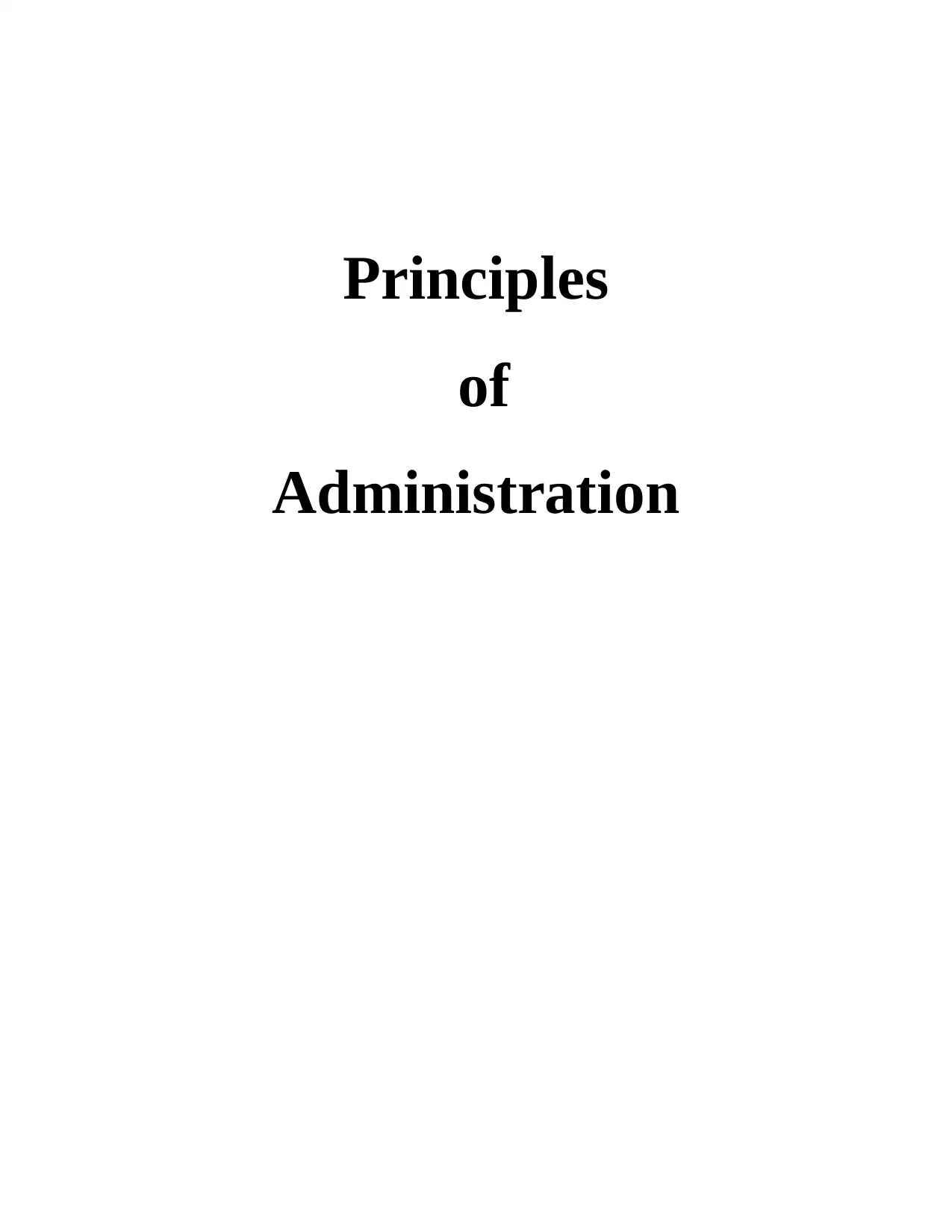
Principles
of
Administration
of
Administration
Paraphrase This Document
Need a fresh take? Get an instant paraphrase of this document with our AI Paraphraser
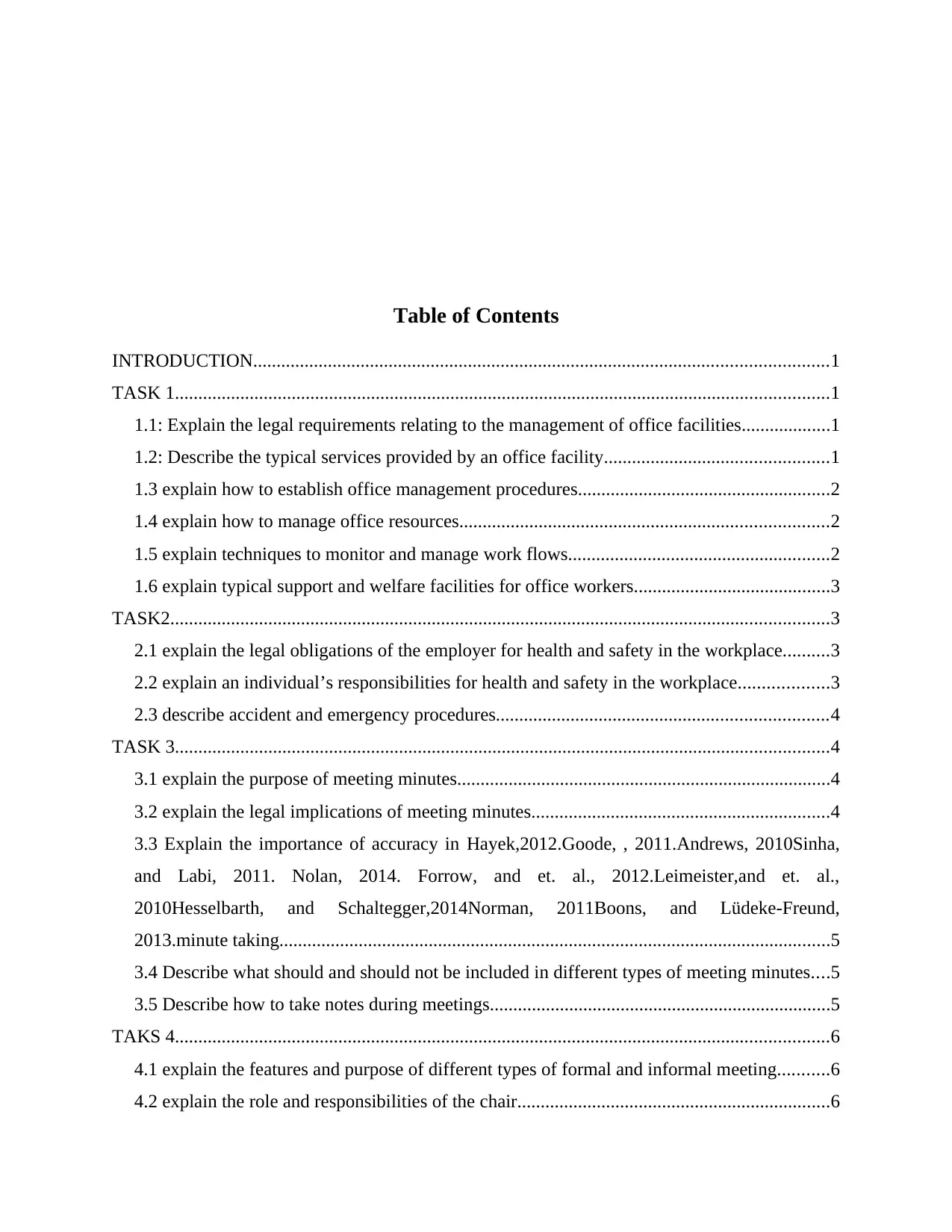
Table of Contents
INTRODUCTION...........................................................................................................................1
TASK 1............................................................................................................................................1
1.1: Explain the legal requirements relating to the management of office facilities...................1
1.2: Describe the typical services provided by an office facility................................................1
1.3 explain how to establish office management procedures......................................................2
1.4 explain how to manage office resources...............................................................................2
1.5 explain techniques to monitor and manage work flows........................................................2
1.6 explain typical support and welfare facilities for office workers..........................................3
TASK2.............................................................................................................................................3
2.1 explain the legal obligations of the employer for health and safety in the workplace..........3
2.2 explain an individual’s responsibilities for health and safety in the workplace...................3
2.3 describe accident and emergency procedures.......................................................................4
TASK 3............................................................................................................................................4
3.1 explain the purpose of meeting minutes................................................................................4
3.2 explain the legal implications of meeting minutes................................................................4
3.3 Explain the importance of accuracy in Hayek,2012.Goode, , 2011.Andrews, 2010Sinha,
and Labi, 2011. Nolan, 2014. Forrow, and et. al., 2012.Leimeister,and et. al.,
2010Hesselbarth, and Schaltegger,2014Norman, 2011Boons, and Lüdeke-Freund,
2013.minute taking......................................................................................................................5
3.4 Describe what should and should not be included in different types of meeting minutes....5
3.5 Describe how to take notes during meetings.........................................................................5
TAKS 4............................................................................................................................................6
4.1 explain the features and purpose of different types of formal and informal meeting...........6
4.2 explain the role and responsibilities of the chair...................................................................6
INTRODUCTION...........................................................................................................................1
TASK 1............................................................................................................................................1
1.1: Explain the legal requirements relating to the management of office facilities...................1
1.2: Describe the typical services provided by an office facility................................................1
1.3 explain how to establish office management procedures......................................................2
1.4 explain how to manage office resources...............................................................................2
1.5 explain techniques to monitor and manage work flows........................................................2
1.6 explain typical support and welfare facilities for office workers..........................................3
TASK2.............................................................................................................................................3
2.1 explain the legal obligations of the employer for health and safety in the workplace..........3
2.2 explain an individual’s responsibilities for health and safety in the workplace...................3
2.3 describe accident and emergency procedures.......................................................................4
TASK 3............................................................................................................................................4
3.1 explain the purpose of meeting minutes................................................................................4
3.2 explain the legal implications of meeting minutes................................................................4
3.3 Explain the importance of accuracy in Hayek,2012.Goode, , 2011.Andrews, 2010Sinha,
and Labi, 2011. Nolan, 2014. Forrow, and et. al., 2012.Leimeister,and et. al.,
2010Hesselbarth, and Schaltegger,2014Norman, 2011Boons, and Lüdeke-Freund,
2013.minute taking......................................................................................................................5
3.4 Describe what should and should not be included in different types of meeting minutes....5
3.5 Describe how to take notes during meetings.........................................................................5
TAKS 4............................................................................................................................................6
4.1 explain the features and purpose of different types of formal and informal meeting...........6
4.2 explain the role and responsibilities of the chair...................................................................6
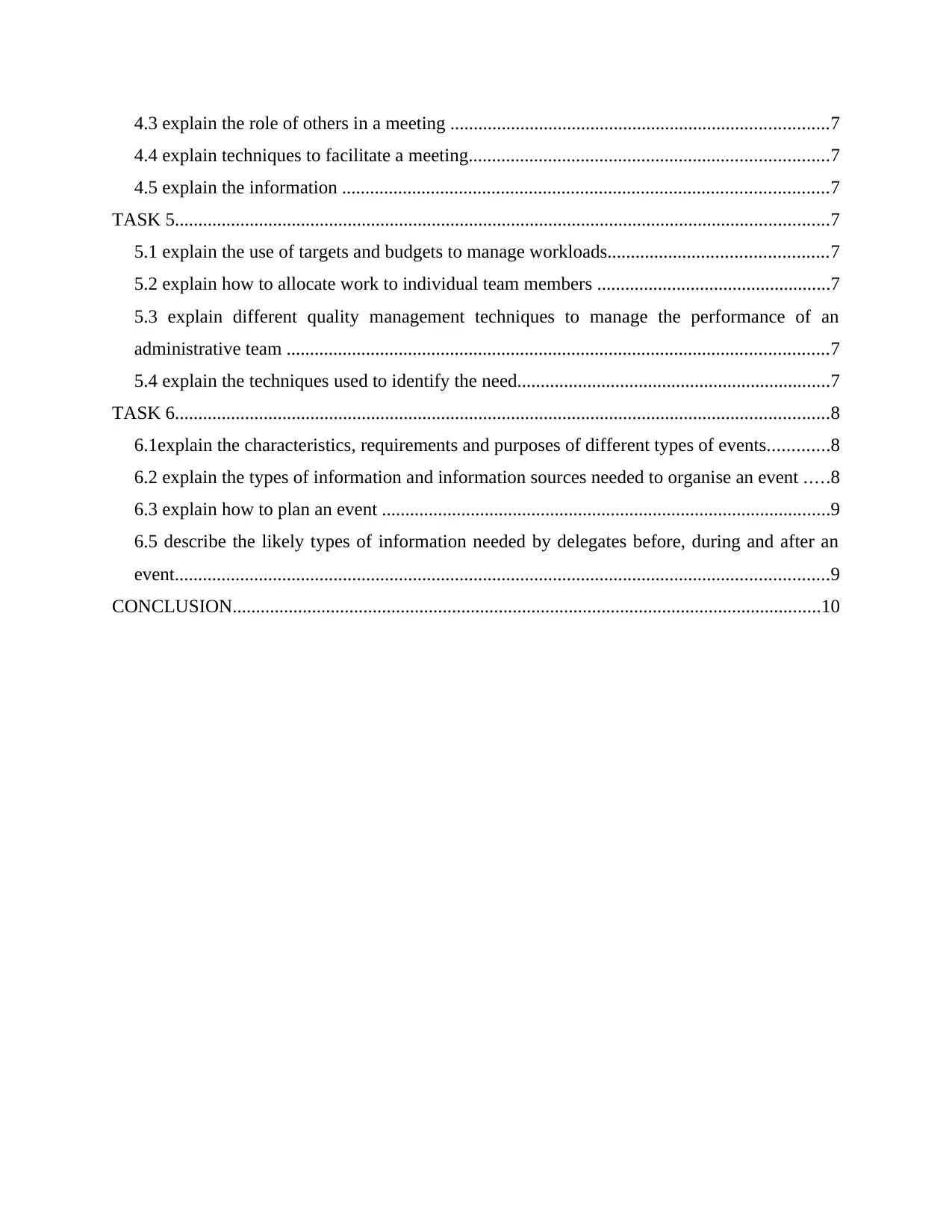
4.3 explain the role of others in a meeting .................................................................................7
4.4 explain techniques to facilitate a meeting.............................................................................7
4.5 explain the information ........................................................................................................7
TASK 5............................................................................................................................................7
5.1 explain the use of targets and budgets to manage workloads...............................................7
5.2 explain how to allocate work to individual team members ..................................................7
5.3 explain different quality management techniques to manage the performance of an
administrative team ....................................................................................................................7
5.4 explain the techniques used to identify the need...................................................................7
TASK 6............................................................................................................................................8
6.1explain the characteristics, requirements and purposes of different types of events.............8
6.2 explain the types of information and information sources needed to organise an event .....8
6.3 explain how to plan an event ................................................................................................9
6.5 describe the likely types of information needed by delegates before, during and after an
event............................................................................................................................................9
CONCLUSION..............................................................................................................................10
4.4 explain techniques to facilitate a meeting.............................................................................7
4.5 explain the information ........................................................................................................7
TASK 5............................................................................................................................................7
5.1 explain the use of targets and budgets to manage workloads...............................................7
5.2 explain how to allocate work to individual team members ..................................................7
5.3 explain different quality management techniques to manage the performance of an
administrative team ....................................................................................................................7
5.4 explain the techniques used to identify the need...................................................................7
TASK 6............................................................................................................................................8
6.1explain the characteristics, requirements and purposes of different types of events.............8
6.2 explain the types of information and information sources needed to organise an event .....8
6.3 explain how to plan an event ................................................................................................9
6.5 describe the likely types of information needed by delegates before, during and after an
event............................................................................................................................................9
CONCLUSION..............................................................................................................................10
⊘ This is a preview!⊘
Do you want full access?
Subscribe today to unlock all pages.

Trusted by 1+ million students worldwide
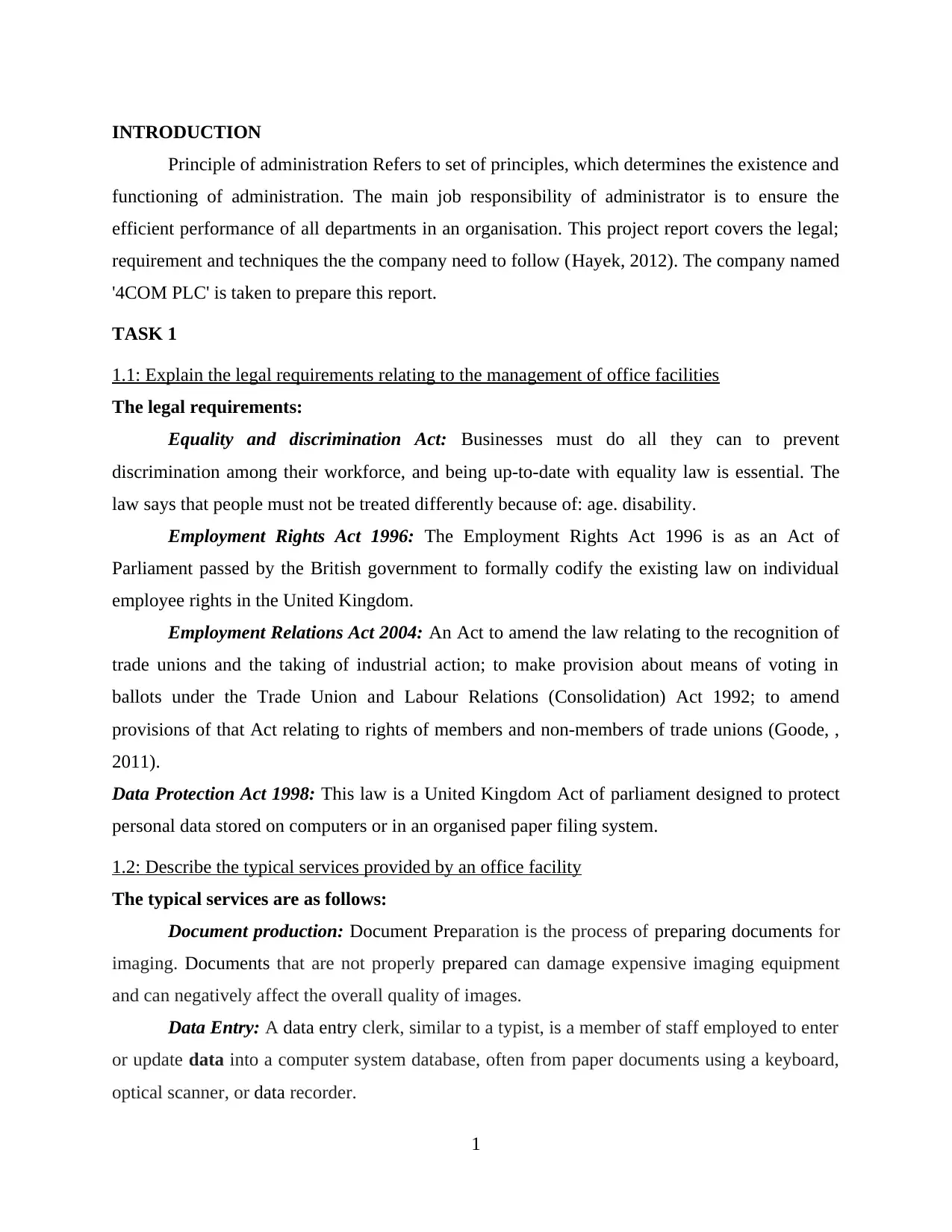
INTRODUCTION
Principle of administration Refers to set of principles, which determines the existence and
functioning of administration. The main job responsibility of administrator is to ensure the
efficient performance of all departments in an organisation. This project report covers the legal;
requirement and techniques the the company need to follow (Hayek, 2012). The company named
'4COM PLC' is taken to prepare this report.
TASK 1
1.1: Explain the legal requirements relating to the management of office facilities
The legal requirements:
Equality and discrimination Act: Businesses must do all they can to prevent
discrimination among their workforce, and being up-to-date with equality law is essential. The
law says that people must not be treated differently because of: age. disability.
Employment Rights Act 1996: The Employment Rights Act 1996 is as an Act of
Parliament passed by the British government to formally codify the existing law on individual
employee rights in the United Kingdom.
Employment Relations Act 2004: An Act to amend the law relating to the recognition of
trade unions and the taking of industrial action; to make provision about means of voting in
ballots under the Trade Union and Labour Relations (Consolidation) Act 1992; to amend
provisions of that Act relating to rights of members and non-members of trade unions (Goode, ,
2011).
Data Protection Act 1998: This law is a United Kingdom Act of parliament designed to protect
personal data stored on computers or in an organised paper filing system.
1.2: Describe the typical services provided by an office facility
The typical services are as follows:
Document production: Document Preparation is the process of preparing documents for
imaging. Documents that are not properly prepared can damage expensive imaging equipment
and can negatively affect the overall quality of images.
Data Entry: A data entry clerk, similar to a typist, is a member of staff employed to enter
or update data into a computer system database, often from paper documents using a keyboard,
optical scanner, or data recorder.
1
Principle of administration Refers to set of principles, which determines the existence and
functioning of administration. The main job responsibility of administrator is to ensure the
efficient performance of all departments in an organisation. This project report covers the legal;
requirement and techniques the the company need to follow (Hayek, 2012). The company named
'4COM PLC' is taken to prepare this report.
TASK 1
1.1: Explain the legal requirements relating to the management of office facilities
The legal requirements:
Equality and discrimination Act: Businesses must do all they can to prevent
discrimination among their workforce, and being up-to-date with equality law is essential. The
law says that people must not be treated differently because of: age. disability.
Employment Rights Act 1996: The Employment Rights Act 1996 is as an Act of
Parliament passed by the British government to formally codify the existing law on individual
employee rights in the United Kingdom.
Employment Relations Act 2004: An Act to amend the law relating to the recognition of
trade unions and the taking of industrial action; to make provision about means of voting in
ballots under the Trade Union and Labour Relations (Consolidation) Act 1992; to amend
provisions of that Act relating to rights of members and non-members of trade unions (Goode, ,
2011).
Data Protection Act 1998: This law is a United Kingdom Act of parliament designed to protect
personal data stored on computers or in an organised paper filing system.
1.2: Describe the typical services provided by an office facility
The typical services are as follows:
Document production: Document Preparation is the process of preparing documents for
imaging. Documents that are not properly prepared can damage expensive imaging equipment
and can negatively affect the overall quality of images.
Data Entry: A data entry clerk, similar to a typist, is a member of staff employed to enter
or update data into a computer system database, often from paper documents using a keyboard,
optical scanner, or data recorder.
1
Paraphrase This Document
Need a fresh take? Get an instant paraphrase of this document with our AI Paraphraser
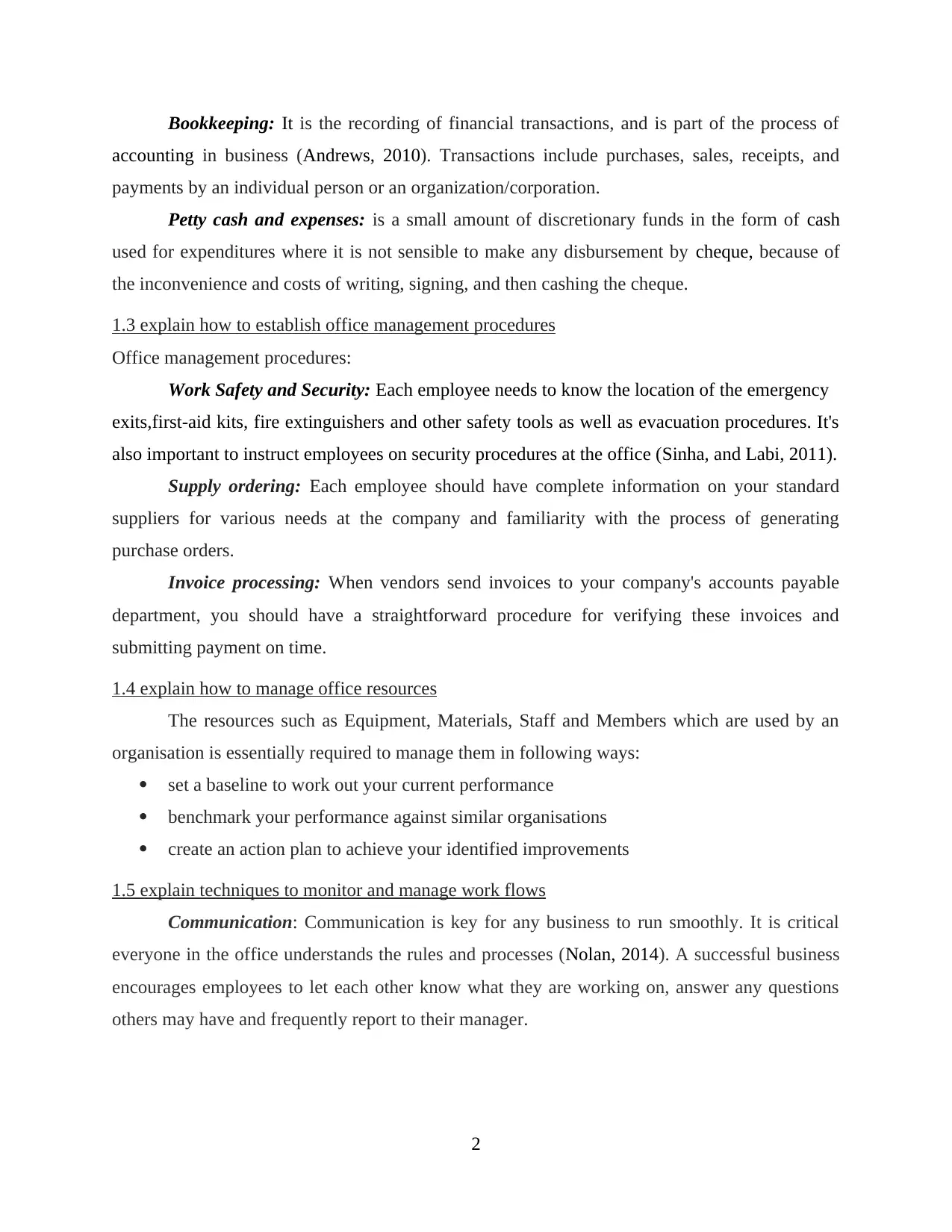
Bookkeeping: It is the recording of financial transactions, and is part of the process of
accounting in business (Andrews, 2010). Transactions include purchases, sales, receipts, and
payments by an individual person or an organization/corporation.
Petty cash and expenses: is a small amount of discretionary funds in the form of cash
used for expenditures where it is not sensible to make any disbursement by cheque, because of
the inconvenience and costs of writing, signing, and then cashing the cheque.
1.3 explain how to establish office management procedures
Office management procedures:
Work Safety and Security: Each employee needs to know the location of the emergency
exits,first-aid kits, fire extinguishers and other safety tools as well as evacuation procedures. It's
also important to instruct employees on security procedures at the office (Sinha, and Labi, 2011).
Supply ordering: Each employee should have complete information on your standard
suppliers for various needs at the company and familiarity with the process of generating
purchase orders.
Invoice processing: When vendors send invoices to your company's accounts payable
department, you should have a straightforward procedure for verifying these invoices and
submitting payment on time.
1.4 explain how to manage office resources
The resources such as Equipment, Materials, Staff and Members which are used by an
organisation is essentially required to manage them in following ways:
set a baseline to work out your current performance
benchmark your performance against similar organisations
create an action plan to achieve your identified improvements
1.5 explain techniques to monitor and manage work flows
Communication: Communication is key for any business to run smoothly. It is critical
everyone in the office understands the rules and processes (Nolan, 2014). A successful business
encourages employees to let each other know what they are working on, answer any questions
others may have and frequently report to their manager.
2
accounting in business (Andrews, 2010). Transactions include purchases, sales, receipts, and
payments by an individual person or an organization/corporation.
Petty cash and expenses: is a small amount of discretionary funds in the form of cash
used for expenditures where it is not sensible to make any disbursement by cheque, because of
the inconvenience and costs of writing, signing, and then cashing the cheque.
1.3 explain how to establish office management procedures
Office management procedures:
Work Safety and Security: Each employee needs to know the location of the emergency
exits,first-aid kits, fire extinguishers and other safety tools as well as evacuation procedures. It's
also important to instruct employees on security procedures at the office (Sinha, and Labi, 2011).
Supply ordering: Each employee should have complete information on your standard
suppliers for various needs at the company and familiarity with the process of generating
purchase orders.
Invoice processing: When vendors send invoices to your company's accounts payable
department, you should have a straightforward procedure for verifying these invoices and
submitting payment on time.
1.4 explain how to manage office resources
The resources such as Equipment, Materials, Staff and Members which are used by an
organisation is essentially required to manage them in following ways:
set a baseline to work out your current performance
benchmark your performance against similar organisations
create an action plan to achieve your identified improvements
1.5 explain techniques to monitor and manage work flows
Communication: Communication is key for any business to run smoothly. It is critical
everyone in the office understands the rules and processes (Nolan, 2014). A successful business
encourages employees to let each other know what they are working on, answer any questions
others may have and frequently report to their manager.
2
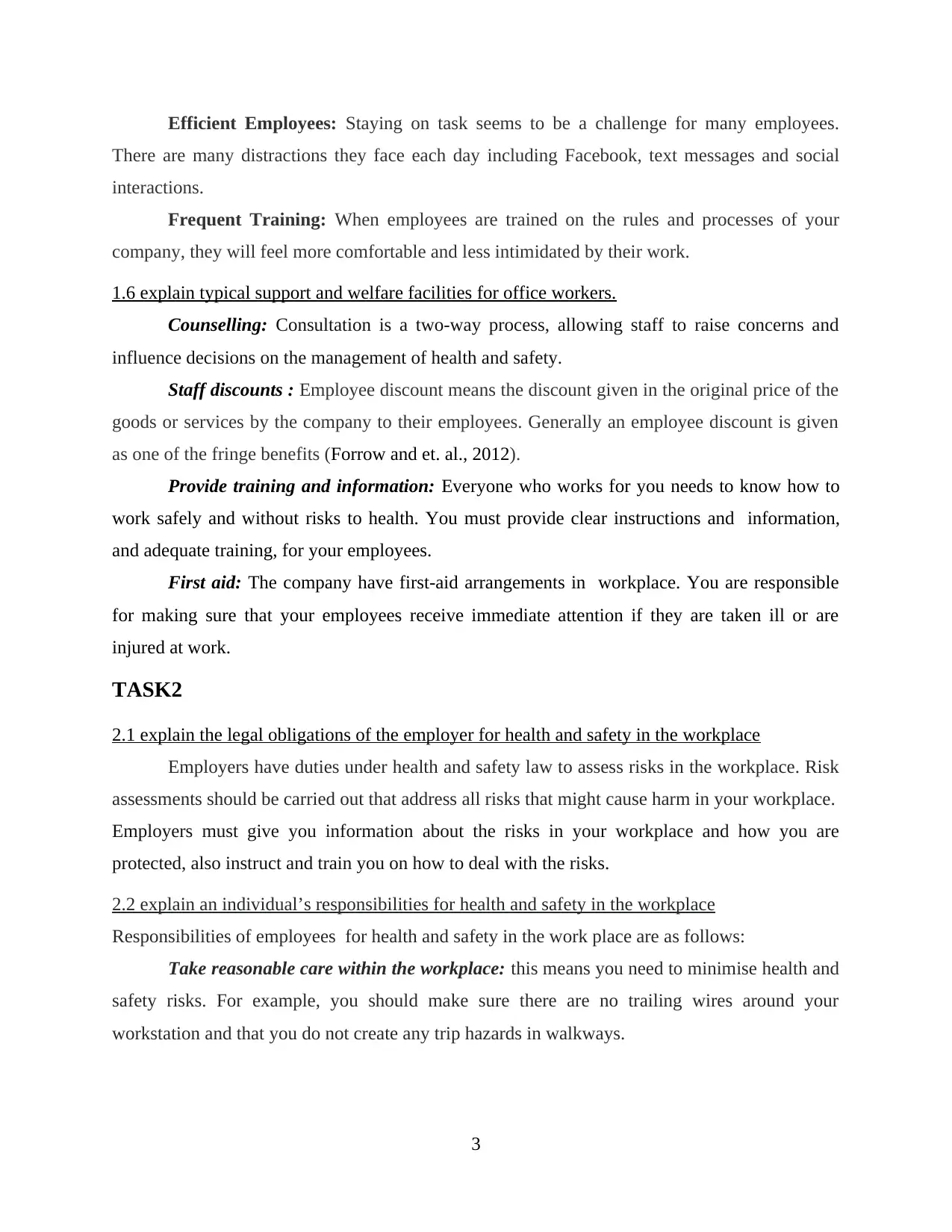
Efficient Employees: Staying on task seems to be a challenge for many employees.
There are many distractions they face each day including Facebook, text messages and social
interactions.
Frequent Training: When employees are trained on the rules and processes of your
company, they will feel more comfortable and less intimidated by their work.
1.6 explain typical support and welfare facilities for office workers.
Counselling: Consultation is a two-way process, allowing staff to raise concerns and
influence decisions on the management of health and safety.
Staff discounts : Employee discount means the discount given in the original price of the
goods or services by the company to their employees. Generally an employee discount is given
as one of the fringe benefits (Forrow and et. al., 2012).
Provide training and information: Everyone who works for you needs to know how to
work safely and without risks to health. You must provide clear instructions and information,
and adequate training, for your employees.
First aid: The company have first-aid arrangements in workplace. You are responsible
for making sure that your employees receive immediate attention if they are taken ill or are
injured at work.
TASK2
2.1 explain the legal obligations of the employer for health and safety in the workplace
Employers have duties under health and safety law to assess risks in the workplace. Risk
assessments should be carried out that address all risks that might cause harm in your workplace.
Employers must give you information about the risks in your workplace and how you are
protected, also instruct and train you on how to deal with the risks.
2.2 explain an individual’s responsibilities for health and safety in the workplace
Responsibilities of employees for health and safety in the work place are as follows:
Take reasonable care within the workplace: this means you need to minimise health and
safety risks. For example, you should make sure there are no trailing wires around your
workstation and that you do not create any trip hazards in walkways.
3
There are many distractions they face each day including Facebook, text messages and social
interactions.
Frequent Training: When employees are trained on the rules and processes of your
company, they will feel more comfortable and less intimidated by their work.
1.6 explain typical support and welfare facilities for office workers.
Counselling: Consultation is a two-way process, allowing staff to raise concerns and
influence decisions on the management of health and safety.
Staff discounts : Employee discount means the discount given in the original price of the
goods or services by the company to their employees. Generally an employee discount is given
as one of the fringe benefits (Forrow and et. al., 2012).
Provide training and information: Everyone who works for you needs to know how to
work safely and without risks to health. You must provide clear instructions and information,
and adequate training, for your employees.
First aid: The company have first-aid arrangements in workplace. You are responsible
for making sure that your employees receive immediate attention if they are taken ill or are
injured at work.
TASK2
2.1 explain the legal obligations of the employer for health and safety in the workplace
Employers have duties under health and safety law to assess risks in the workplace. Risk
assessments should be carried out that address all risks that might cause harm in your workplace.
Employers must give you information about the risks in your workplace and how you are
protected, also instruct and train you on how to deal with the risks.
2.2 explain an individual’s responsibilities for health and safety in the workplace
Responsibilities of employees for health and safety in the work place are as follows:
Take reasonable care within the workplace: this means you need to minimise health and
safety risks. For example, you should make sure there are no trailing wires around your
workstation and that you do not create any trip hazards in walkways.
3
⊘ This is a preview!⊘
Do you want full access?
Subscribe today to unlock all pages.

Trusted by 1+ million students worldwide
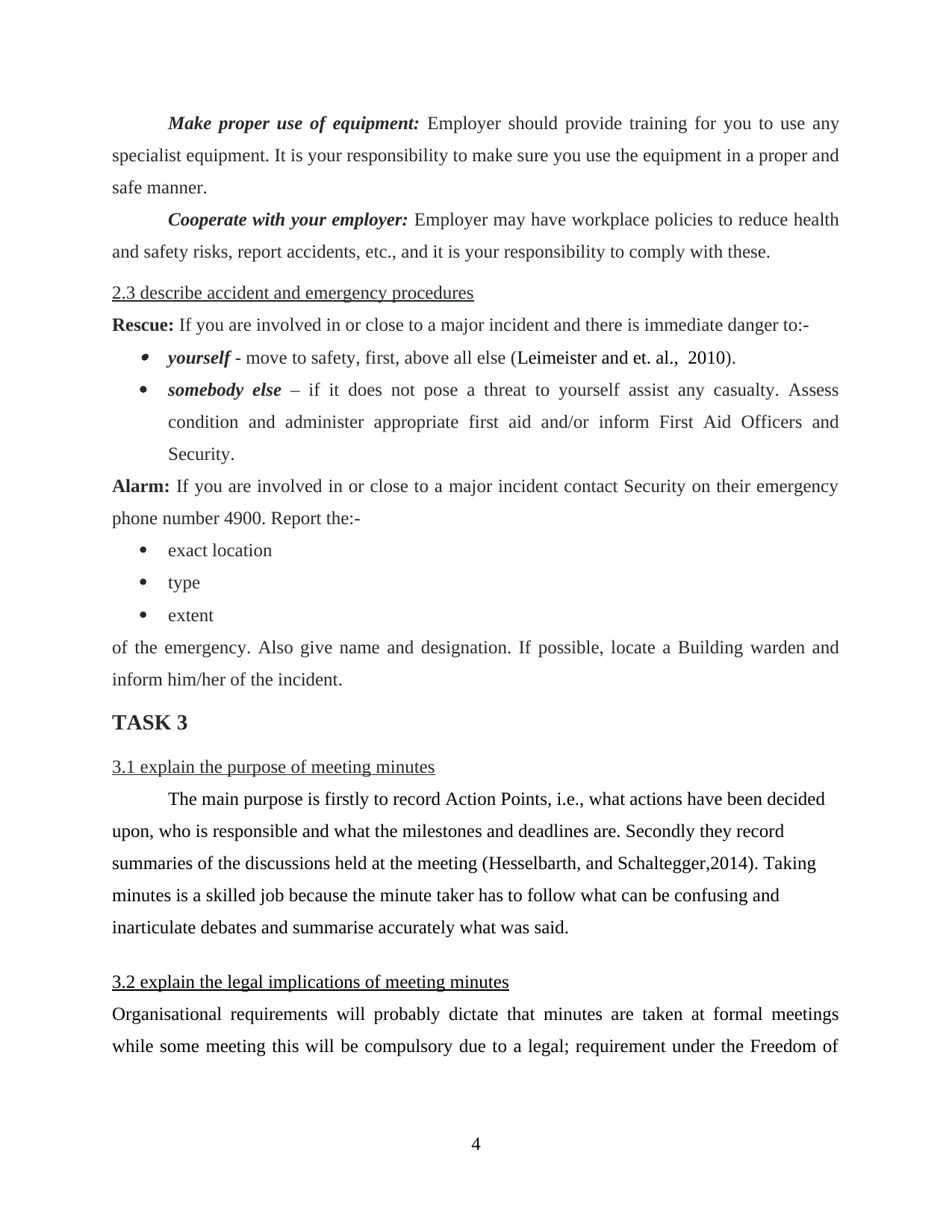
Make proper use of equipment: Employer should provide training for you to use any
specialist equipment. It is your responsibility to make sure you use the equipment in a proper and
safe manner.
Cooperate with your employer: Employer may have workplace policies to reduce health
and safety risks, report accidents, etc., and it is your responsibility to comply with these.
2.3 describe accident and emergency procedures
Rescue: If you are involved in or close to a major incident and there is immediate danger to:- yourself - move to safety, first, above all else (Leimeister and et. al., 2010).
somebody else – if it does not pose a threat to yourself assist any casualty. Assess
condition and administer appropriate first aid and/or inform First Aid Officers and
Security.
Alarm: If you are involved in or close to a major incident contact Security on their emergency
phone number 4900. Report the:-
exact location
type
extent
of the emergency. Also give name and designation. If possible, locate a Building warden and
inform him/her of the incident.
TASK 3
3.1 explain the purpose of meeting minutes
The main purpose is firstly to record Action Points, i.e., what actions have been decided
upon, who is responsible and what the milestones and deadlines are. Secondly they record
summaries of the discussions held at the meeting (Hesselbarth, and Schaltegger,2014). Taking
minutes is a skilled job because the minute taker has to follow what can be confusing and
inarticulate debates and summarise accurately what was said.
3.2 explain the legal implications of meeting minutes
Organisational requirements will probably dictate that minutes are taken at formal meetings
while some meeting this will be compulsory due to a legal; requirement under the Freedom of
4
specialist equipment. It is your responsibility to make sure you use the equipment in a proper and
safe manner.
Cooperate with your employer: Employer may have workplace policies to reduce health
and safety risks, report accidents, etc., and it is your responsibility to comply with these.
2.3 describe accident and emergency procedures
Rescue: If you are involved in or close to a major incident and there is immediate danger to:- yourself - move to safety, first, above all else (Leimeister and et. al., 2010).
somebody else – if it does not pose a threat to yourself assist any casualty. Assess
condition and administer appropriate first aid and/or inform First Aid Officers and
Security.
Alarm: If you are involved in or close to a major incident contact Security on their emergency
phone number 4900. Report the:-
exact location
type
extent
of the emergency. Also give name and designation. If possible, locate a Building warden and
inform him/her of the incident.
TASK 3
3.1 explain the purpose of meeting minutes
The main purpose is firstly to record Action Points, i.e., what actions have been decided
upon, who is responsible and what the milestones and deadlines are. Secondly they record
summaries of the discussions held at the meeting (Hesselbarth, and Schaltegger,2014). Taking
minutes is a skilled job because the minute taker has to follow what can be confusing and
inarticulate debates and summarise accurately what was said.
3.2 explain the legal implications of meeting minutes
Organisational requirements will probably dictate that minutes are taken at formal meetings
while some meeting this will be compulsory due to a legal; requirement under the Freedom of
4
Paraphrase This Document
Need a fresh take? Get an instant paraphrase of this document with our AI Paraphraser
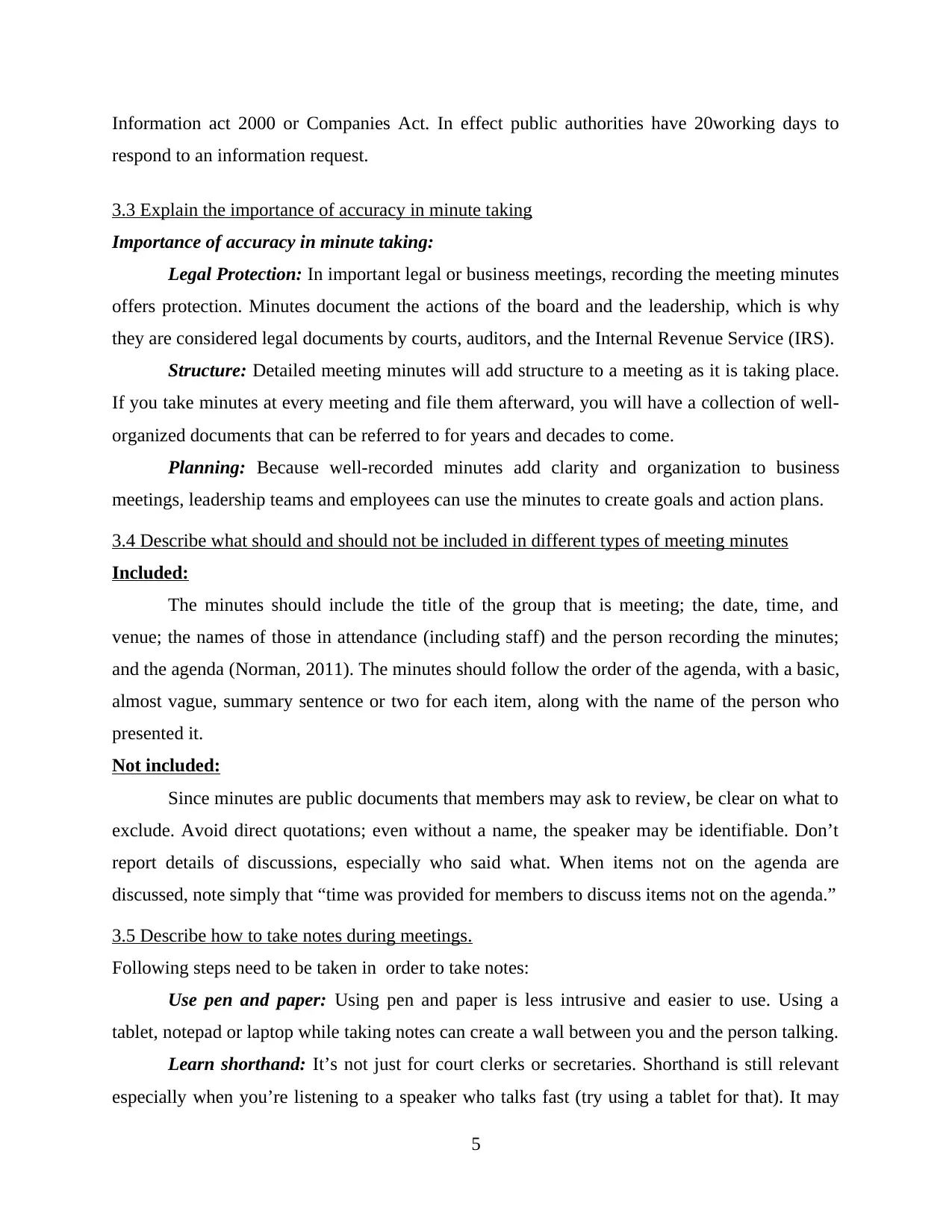
Information act 2000 or Companies Act. In effect public authorities have 20working days to
respond to an information request.
3.3 Explain the importance of accuracy in minute taking
Importance of accuracy in minute taking:
Legal Protection: In important legal or business meetings, recording the meeting minutes
offers protection. Minutes document the actions of the board and the leadership, which is why
they are considered legal documents by courts, auditors, and the Internal Revenue Service (IRS).
Structure: Detailed meeting minutes will add structure to a meeting as it is taking place.
If you take minutes at every meeting and file them afterward, you will have a collection of well-
organized documents that can be referred to for years and decades to come.
Planning: Because well-recorded minutes add clarity and organization to business
meetings, leadership teams and employees can use the minutes to create goals and action plans.
3.4 Describe what should and should not be included in different types of meeting minutes
Included:
The minutes should include the title of the group that is meeting; the date, time, and
venue; the names of those in attendance (including staff) and the person recording the minutes;
and the agenda (Norman, 2011). The minutes should follow the order of the agenda, with a basic,
almost vague, summary sentence or two for each item, along with the name of the person who
presented it.
Not included:
Since minutes are public documents that members may ask to review, be clear on what to
exclude. Avoid direct quotations; even without a name, the speaker may be identifiable. Don’t
report details of discussions, especially who said what. When items not on the agenda are
discussed, note simply that “time was provided for members to discuss items not on the agenda.”
3.5 Describe how to take notes during meetings.
Following steps need to be taken in order to take notes:
Use pen and paper: Using pen and paper is less intrusive and easier to use. Using a
tablet, notepad or laptop while taking notes can create a wall between you and the person talking.
Learn shorthand: It’s not just for court clerks or secretaries. Shorthand is still relevant
especially when you’re listening to a speaker who talks fast (try using a tablet for that). It may
5
respond to an information request.
3.3 Explain the importance of accuracy in minute taking
Importance of accuracy in minute taking:
Legal Protection: In important legal or business meetings, recording the meeting minutes
offers protection. Minutes document the actions of the board and the leadership, which is why
they are considered legal documents by courts, auditors, and the Internal Revenue Service (IRS).
Structure: Detailed meeting minutes will add structure to a meeting as it is taking place.
If you take minutes at every meeting and file them afterward, you will have a collection of well-
organized documents that can be referred to for years and decades to come.
Planning: Because well-recorded minutes add clarity and organization to business
meetings, leadership teams and employees can use the minutes to create goals and action plans.
3.4 Describe what should and should not be included in different types of meeting minutes
Included:
The minutes should include the title of the group that is meeting; the date, time, and
venue; the names of those in attendance (including staff) and the person recording the minutes;
and the agenda (Norman, 2011). The minutes should follow the order of the agenda, with a basic,
almost vague, summary sentence or two for each item, along with the name of the person who
presented it.
Not included:
Since minutes are public documents that members may ask to review, be clear on what to
exclude. Avoid direct quotations; even without a name, the speaker may be identifiable. Don’t
report details of discussions, especially who said what. When items not on the agenda are
discussed, note simply that “time was provided for members to discuss items not on the agenda.”
3.5 Describe how to take notes during meetings.
Following steps need to be taken in order to take notes:
Use pen and paper: Using pen and paper is less intrusive and easier to use. Using a
tablet, notepad or laptop while taking notes can create a wall between you and the person talking.
Learn shorthand: It’s not just for court clerks or secretaries. Shorthand is still relevant
especially when you’re listening to a speaker who talks fast (try using a tablet for that). It may
5
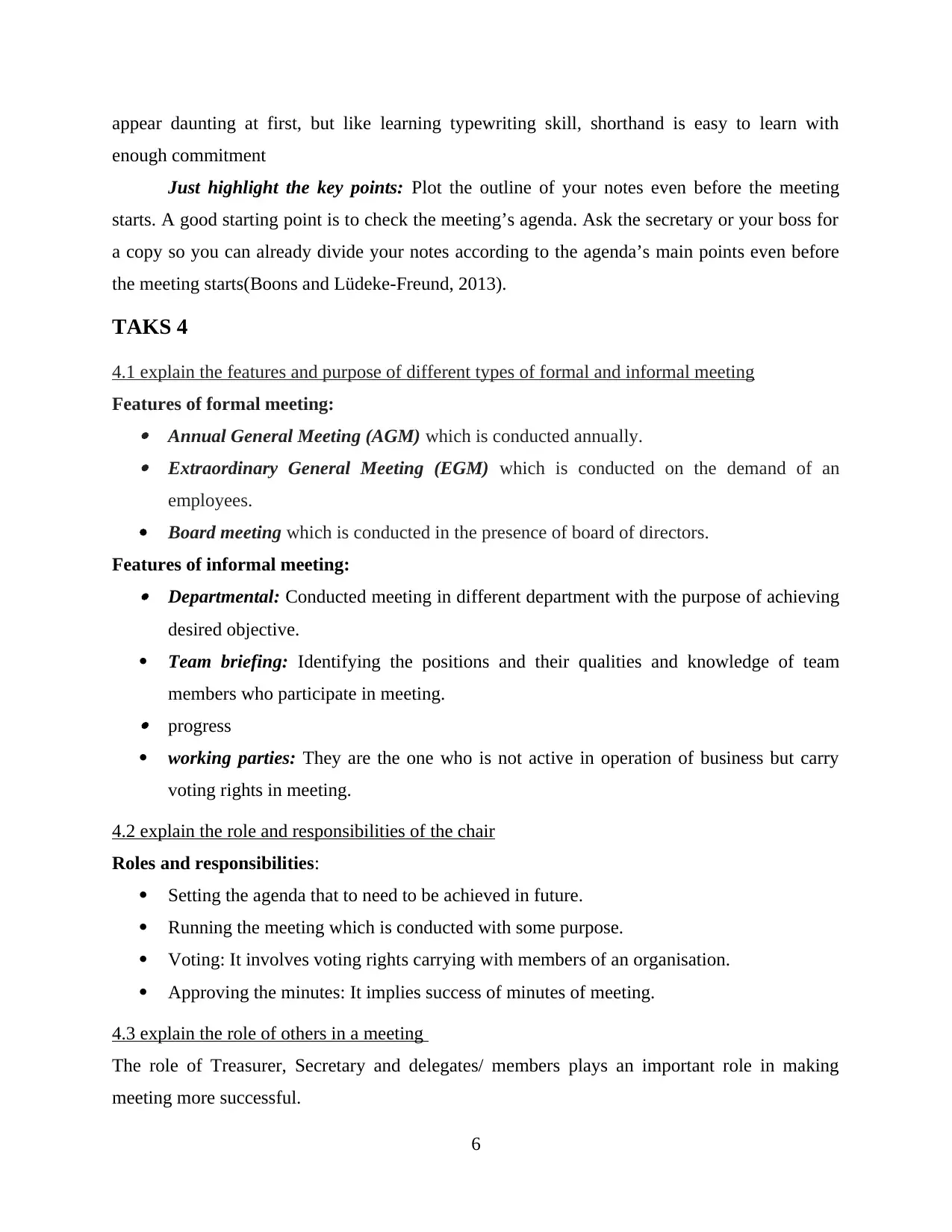
appear daunting at first, but like learning typewriting skill, shorthand is easy to learn with
enough commitment
Just highlight the key points: Plot the outline of your notes even before the meeting
starts. A good starting point is to check the meeting’s agenda. Ask the secretary or your boss for
a copy so you can already divide your notes according to the agenda’s main points even before
the meeting starts(Boons and Lüdeke-Freund, 2013).
TAKS 4
4.1 explain the features and purpose of different types of formal and informal meeting
Features of formal meeting: Annual General Meeting (AGM) which is conducted annually. Extraordinary General Meeting (EGM) which is conducted on the demand of an
employees.
Board meeting which is conducted in the presence of board of directors.
Features of informal meeting: Departmental: Conducted meeting in different department with the purpose of achieving
desired objective.
Team briefing: Identifying the positions and their qualities and knowledge of team
members who participate in meeting. progress
working parties: They are the one who is not active in operation of business but carry
voting rights in meeting.
4.2 explain the role and responsibilities of the chair
Roles and responsibilities:
Setting the agenda that to need to be achieved in future.
Running the meeting which is conducted with some purpose.
Voting: It involves voting rights carrying with members of an organisation.
Approving the minutes: It implies success of minutes of meeting.
4.3 explain the role of others in a meeting
The role of Treasurer, Secretary and delegates/ members plays an important role in making
meeting more successful.
6
enough commitment
Just highlight the key points: Plot the outline of your notes even before the meeting
starts. A good starting point is to check the meeting’s agenda. Ask the secretary or your boss for
a copy so you can already divide your notes according to the agenda’s main points even before
the meeting starts(Boons and Lüdeke-Freund, 2013).
TAKS 4
4.1 explain the features and purpose of different types of formal and informal meeting
Features of formal meeting: Annual General Meeting (AGM) which is conducted annually. Extraordinary General Meeting (EGM) which is conducted on the demand of an
employees.
Board meeting which is conducted in the presence of board of directors.
Features of informal meeting: Departmental: Conducted meeting in different department with the purpose of achieving
desired objective.
Team briefing: Identifying the positions and their qualities and knowledge of team
members who participate in meeting. progress
working parties: They are the one who is not active in operation of business but carry
voting rights in meeting.
4.2 explain the role and responsibilities of the chair
Roles and responsibilities:
Setting the agenda that to need to be achieved in future.
Running the meeting which is conducted with some purpose.
Voting: It involves voting rights carrying with members of an organisation.
Approving the minutes: It implies success of minutes of meeting.
4.3 explain the role of others in a meeting
The role of Treasurer, Secretary and delegates/ members plays an important role in making
meeting more successful.
6
⊘ This is a preview!⊘
Do you want full access?
Subscribe today to unlock all pages.

Trusted by 1+ million students worldwide
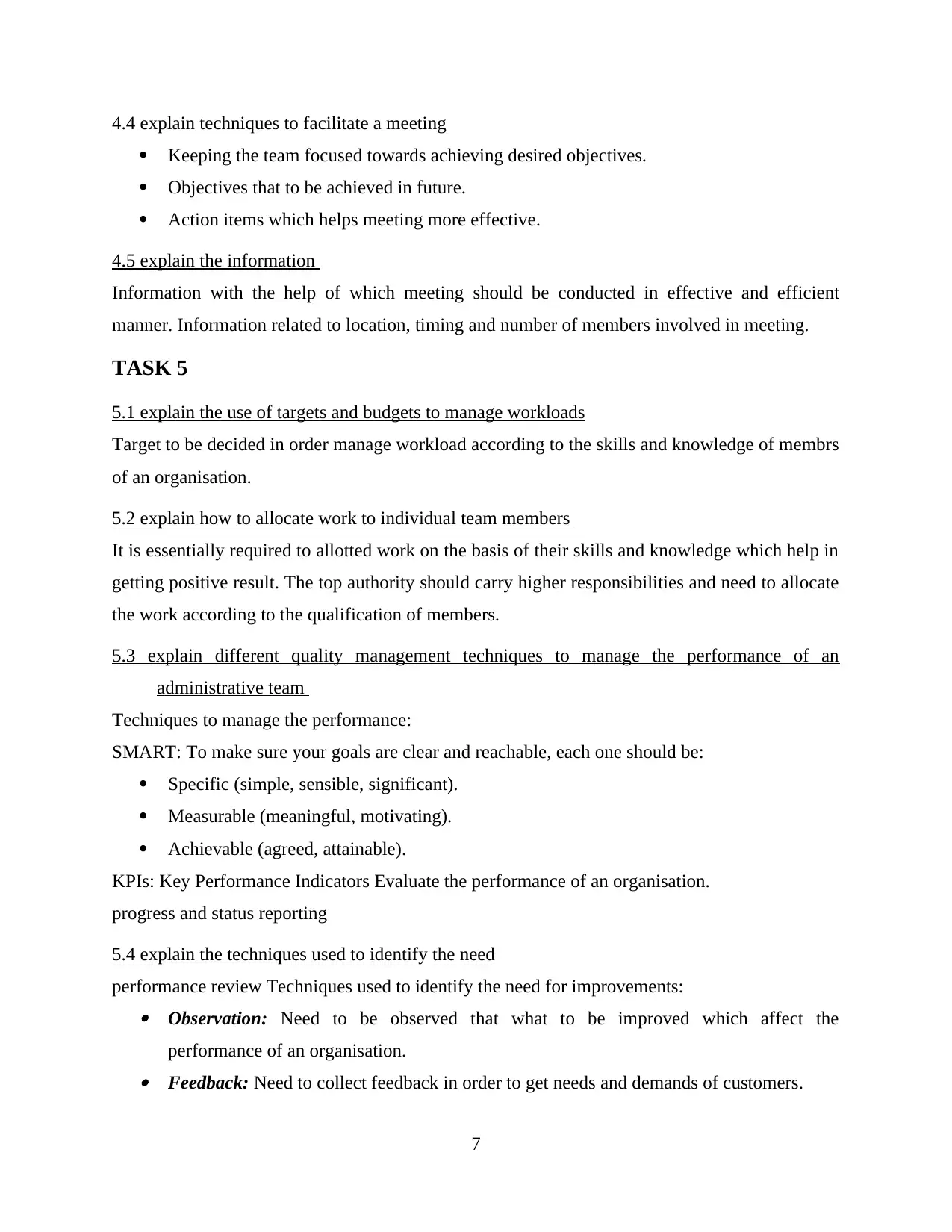
4.4 explain techniques to facilitate a meeting
Keeping the team focused towards achieving desired objectives.
Objectives that to be achieved in future.
Action items which helps meeting more effective.
4.5 explain the information
Information with the help of which meeting should be conducted in effective and efficient
manner. Information related to location, timing and number of members involved in meeting.
TASK 5
5.1 explain the use of targets and budgets to manage workloads
Target to be decided in order manage workload according to the skills and knowledge of membrs
of an organisation.
5.2 explain how to allocate work to individual team members
It is essentially required to allotted work on the basis of their skills and knowledge which help in
getting positive result. The top authority should carry higher responsibilities and need to allocate
the work according to the qualification of members.
5.3 explain different quality management techniques to manage the performance of an
administrative team
Techniques to manage the performance:
SMART: To make sure your goals are clear and reachable, each one should be:
Specific (simple, sensible, significant).
Measurable (meaningful, motivating).
Achievable (agreed, attainable).
KPIs: Key Performance Indicators Evaluate the performance of an organisation.
progress and status reporting
5.4 explain the techniques used to identify the need
performance review Techniques used to identify the need for improvements: Observation: Need to be observed that what to be improved which affect the
performance of an organisation. Feedback: Need to collect feedback in order to get needs and demands of customers.
7
Keeping the team focused towards achieving desired objectives.
Objectives that to be achieved in future.
Action items which helps meeting more effective.
4.5 explain the information
Information with the help of which meeting should be conducted in effective and efficient
manner. Information related to location, timing and number of members involved in meeting.
TASK 5
5.1 explain the use of targets and budgets to manage workloads
Target to be decided in order manage workload according to the skills and knowledge of membrs
of an organisation.
5.2 explain how to allocate work to individual team members
It is essentially required to allotted work on the basis of their skills and knowledge which help in
getting positive result. The top authority should carry higher responsibilities and need to allocate
the work according to the qualification of members.
5.3 explain different quality management techniques to manage the performance of an
administrative team
Techniques to manage the performance:
SMART: To make sure your goals are clear and reachable, each one should be:
Specific (simple, sensible, significant).
Measurable (meaningful, motivating).
Achievable (agreed, attainable).
KPIs: Key Performance Indicators Evaluate the performance of an organisation.
progress and status reporting
5.4 explain the techniques used to identify the need
performance review Techniques used to identify the need for improvements: Observation: Need to be observed that what to be improved which affect the
performance of an organisation. Feedback: Need to collect feedback in order to get needs and demands of customers.
7
Paraphrase This Document
Need a fresh take? Get an instant paraphrase of this document with our AI Paraphraser
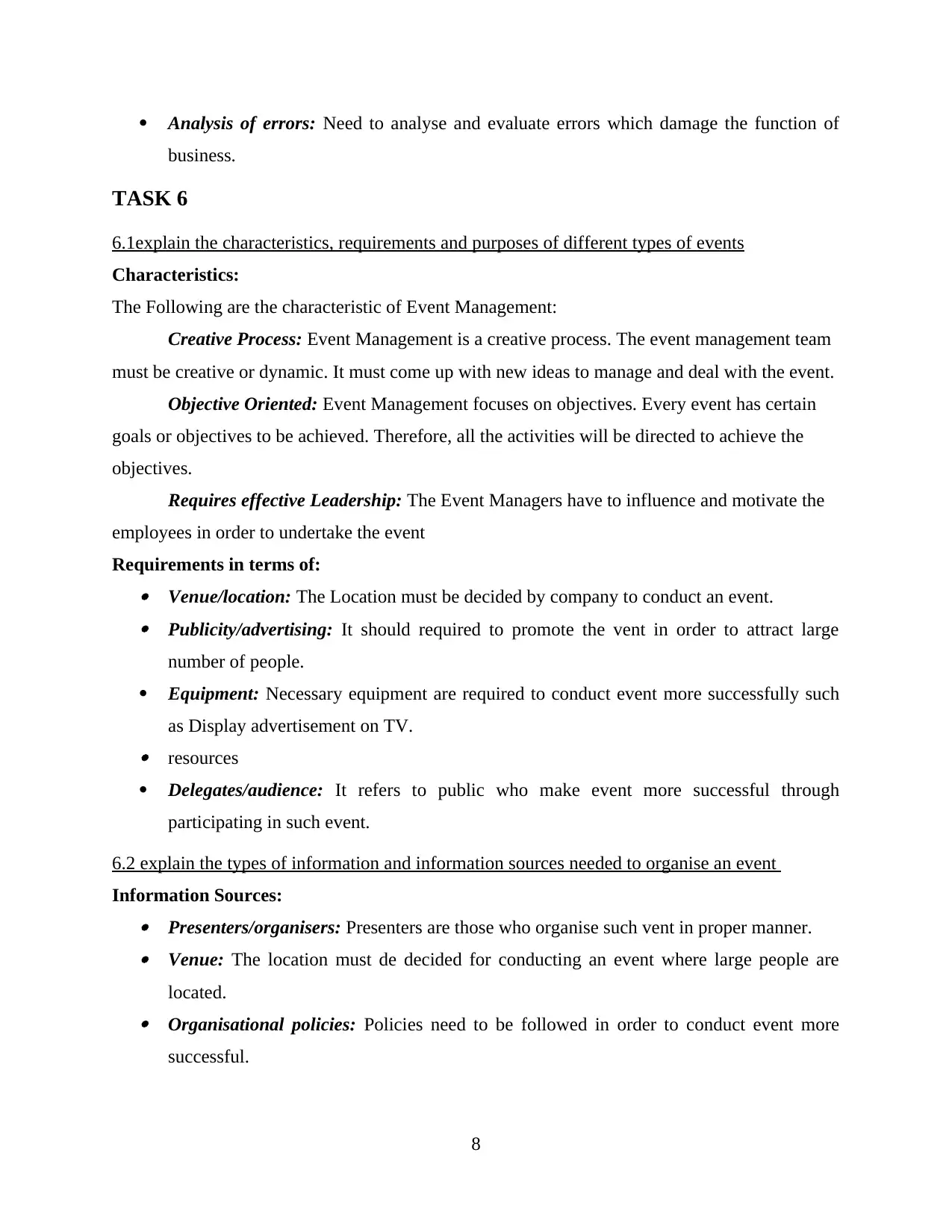
Analysis of errors: Need to analyse and evaluate errors which damage the function of
business.
TASK 6
6.1explain the characteristics, requirements and purposes of different types of events
Characteristics:
The Following are the characteristic of Event Management:
Creative Process: Event Management is a creative process. The event management team
must be creative or dynamic. It must come up with new ideas to manage and deal with the event.
Objective Oriented: Event Management focuses on objectives. Every event has certain
goals or objectives to be achieved. Therefore, all the activities will be directed to achieve the
objectives.
Requires effective Leadership: The Event Managers have to influence and motivate the
employees in order to undertake the event
Requirements in terms of: Venue/location: The Location must be decided by company to conduct an event. Publicity/advertising: It should required to promote the vent in order to attract large
number of people.
Equipment: Necessary equipment are required to conduct event more successfully such
as Display advertisement on TV. resources
Delegates/audience: It refers to public who make event more successful through
participating in such event.
6.2 explain the types of information and information sources needed to organise an event
Information Sources: Presenters/organisers: Presenters are those who organise such vent in proper manner. Venue: The location must de decided for conducting an event where large people are
located. Organisational policies: Policies need to be followed in order to conduct event more
successful.
8
business.
TASK 6
6.1explain the characteristics, requirements and purposes of different types of events
Characteristics:
The Following are the characteristic of Event Management:
Creative Process: Event Management is a creative process. The event management team
must be creative or dynamic. It must come up with new ideas to manage and deal with the event.
Objective Oriented: Event Management focuses on objectives. Every event has certain
goals or objectives to be achieved. Therefore, all the activities will be directed to achieve the
objectives.
Requires effective Leadership: The Event Managers have to influence and motivate the
employees in order to undertake the event
Requirements in terms of: Venue/location: The Location must be decided by company to conduct an event. Publicity/advertising: It should required to promote the vent in order to attract large
number of people.
Equipment: Necessary equipment are required to conduct event more successfully such
as Display advertisement on TV. resources
Delegates/audience: It refers to public who make event more successful through
participating in such event.
6.2 explain the types of information and information sources needed to organise an event
Information Sources: Presenters/organisers: Presenters are those who organise such vent in proper manner. Venue: The location must de decided for conducting an event where large people are
located. Organisational policies: Policies need to be followed in order to conduct event more
successful.
8
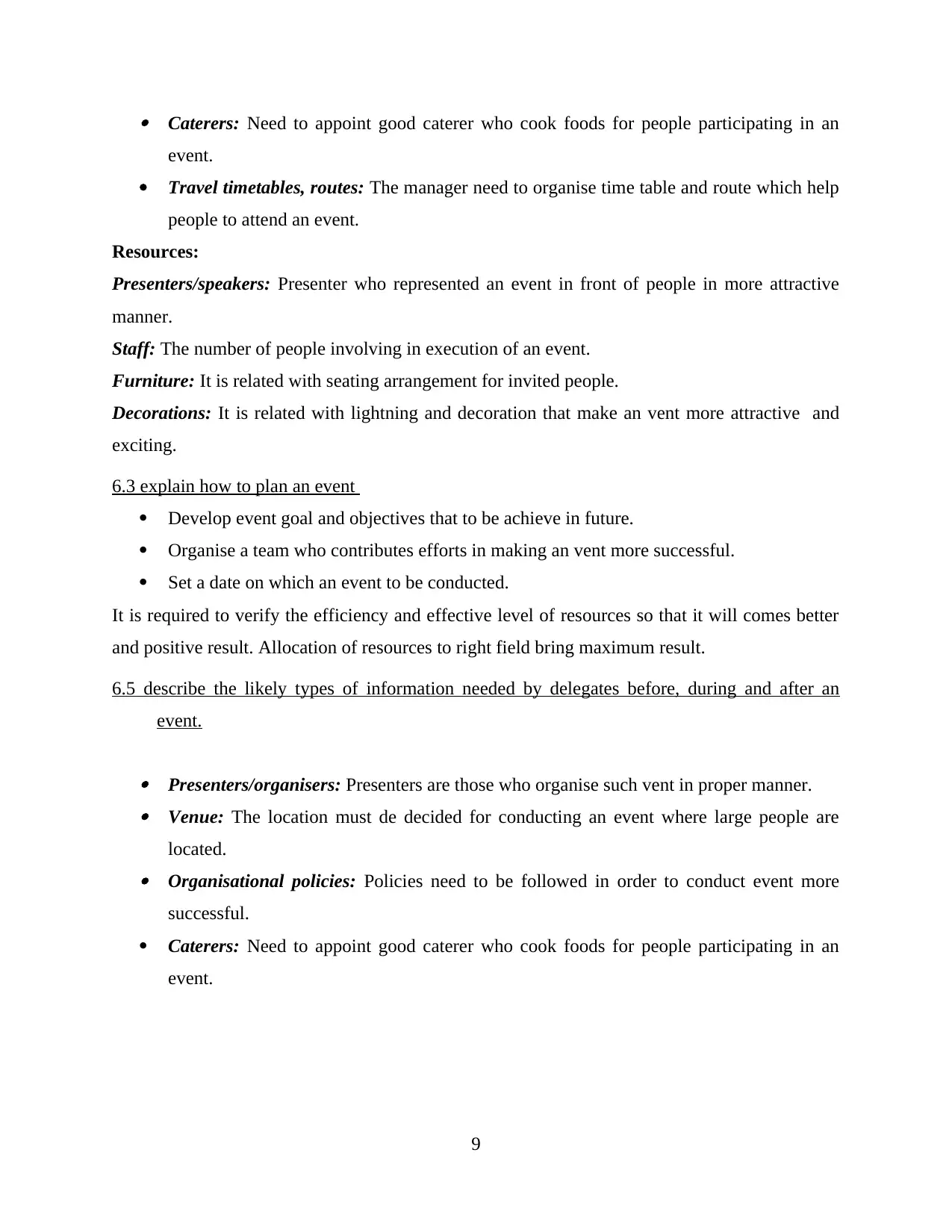
Caterers: Need to appoint good caterer who cook foods for people participating in an
event.
Travel timetables, routes: The manager need to organise time table and route which help
people to attend an event.
Resources:
Presenters/speakers: Presenter who represented an event in front of people in more attractive
manner.
Staff: The number of people involving in execution of an event.
Furniture: It is related with seating arrangement for invited people.
Decorations: It is related with lightning and decoration that make an vent more attractive and
exciting.
6.3 explain how to plan an event
Develop event goal and objectives that to be achieve in future.
Organise a team who contributes efforts in making an vent more successful.
Set a date on which an event to be conducted.
It is required to verify the efficiency and effective level of resources so that it will comes better
and positive result. Allocation of resources to right field bring maximum result.
6.5 describe the likely types of information needed by delegates before, during and after an
event.
Presenters/organisers: Presenters are those who organise such vent in proper manner. Venue: The location must de decided for conducting an event where large people are
located. Organisational policies: Policies need to be followed in order to conduct event more
successful.
Caterers: Need to appoint good caterer who cook foods for people participating in an
event.
9
event.
Travel timetables, routes: The manager need to organise time table and route which help
people to attend an event.
Resources:
Presenters/speakers: Presenter who represented an event in front of people in more attractive
manner.
Staff: The number of people involving in execution of an event.
Furniture: It is related with seating arrangement for invited people.
Decorations: It is related with lightning and decoration that make an vent more attractive and
exciting.
6.3 explain how to plan an event
Develop event goal and objectives that to be achieve in future.
Organise a team who contributes efforts in making an vent more successful.
Set a date on which an event to be conducted.
It is required to verify the efficiency and effective level of resources so that it will comes better
and positive result. Allocation of resources to right field bring maximum result.
6.5 describe the likely types of information needed by delegates before, during and after an
event.
Presenters/organisers: Presenters are those who organise such vent in proper manner. Venue: The location must de decided for conducting an event where large people are
located. Organisational policies: Policies need to be followed in order to conduct event more
successful.
Caterers: Need to appoint good caterer who cook foods for people participating in an
event.
9
⊘ This is a preview!⊘
Do you want full access?
Subscribe today to unlock all pages.

Trusted by 1+ million students worldwide
1 out of 14
Related Documents
Your All-in-One AI-Powered Toolkit for Academic Success.
+13062052269
info@desklib.com
Available 24*7 on WhatsApp / Email
![[object Object]](/_next/static/media/star-bottom.7253800d.svg)
Unlock your academic potential
Copyright © 2020–2025 A2Z Services. All Rights Reserved. Developed and managed by ZUCOL.





